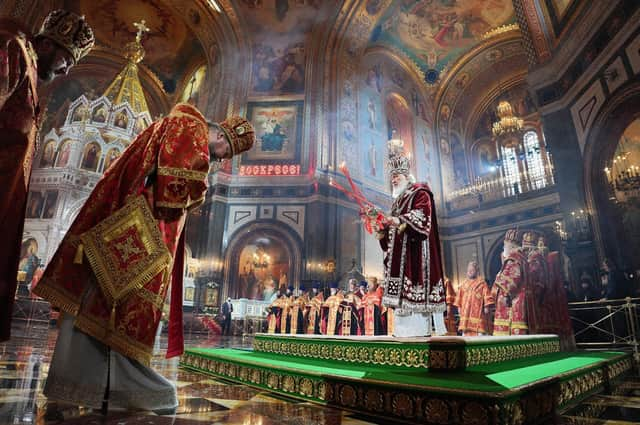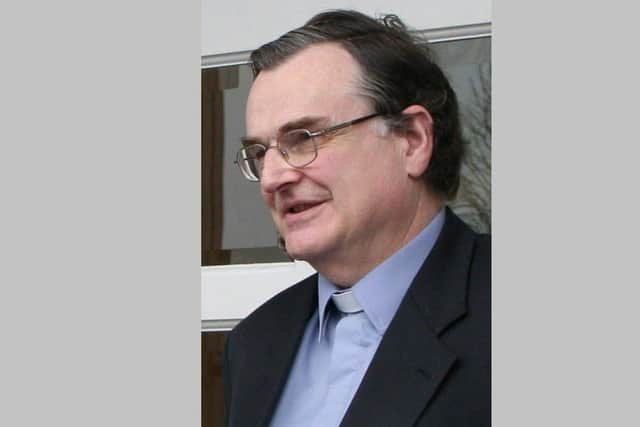Putin seeks his own Holy Russian Empire – and church leader in Moscow is helping


Over the centuries there have been several major splits within the Christian church. The Reformation in the 16th century in fact took different forms, with the English approach being distinct from the continental in certain respects.
Some 500 years earlier in 1054 there was a schism between the Western church and the Eastern Orthodox.
Advertisement
Hide AdAdvertisement
Hide AdEven earlier, in the mid-5th century, there had been a split in north Africa and parts of the Middle East when the Oriental Orthodox broke away from the rest of the church.


Some of the geographical regions of Orthodoxy are known as ‘Patriarchates’. They are termed ‘autocephalous’, meaning they’re not subject to any ecclesiastical authority beyond themselves.
Within Eastern Orthodoxy, the Patriarch of Constantinople exercises a leadership of honour. Constantinople was the earlier name for Istanbul, the change reflecting the fact that Turkey became largely a Muslim country.
However, in the Eastern Orthodox Church, the Patriarch there is still called the Patriarch of Constantinople.
Advertisement
Hide AdAdvertisement
Hide AdThe Orthodox presence in Ukraine prior to 2018 was somewhat complex and fragmented.
Dr Brandon Gallaher, a University of Exeter theologian and recognised expert in the subject, and who happens to have family roots in Northern Ireland, explained to me for this column that before 2018 there were three main Orthodox churches in the country:
1) One coming under the Moscow Patriarchate;
2) A Kiev Patriarchate church established in 1992;
3) and The Ukrainian Autocephalous Orthodox Church, which had roots from the 1920s.
In 2018, under the Eastern Orthodox leadership of Patriarch Bartholomew of Constantinople, a meeting of representatives from these three churches was held and it led to the creation of a new, united autocephalous church known as the Orthodox Church of Ukraine, although only a few bishops from the Moscow Patriarchate Ukrainian church were involved.
Advertisement
Hide AdAdvertisement
Hide AdIntra-Orthodox disputes and power struggling, involving non-attendance by the influential Moscow Patriarchate, hampered a 2016 Pan-Orthodox Council meeting in Crete.
The current war has served to deepen the rift even further, especially given the fact that Patriarch Kirill of Moscow has openly supported President Putin’s aggression in Ukraine.
Indeed, the Moscow Patriarch is reportedly himself a former KGB agent and faces planned western sanctions.
He has now become decidedly isolated within the worldwide Christian church, including within the Orthodox family.
Advertisement
Hide AdAdvertisement
Hide AdIn fact, Dr Gallaher was one of the main drafters of a document challenging the current Russian aggression in Ukraine and entitled, ‘Declaration on the Russian World Teaching’.
He told me it was signed by 1,400 scholars, including most leading Orthodox scholars.
That declaration in turn inspired over 400 clergy of the remaining Moscow Patriarchate Orthodox church in Ukraine to write an open letter demanding that their own Patriarch, Kirill of Moscow, be ecclesiastically tried for committing moral crimes in blessing the war and for heretical views about the Russian world.
Patriarch Kirill and Vladimir Putin over the past 20 years or so have promoted the idea of a Russian order, known as Russkii Mir (Russian World), an ideology which has a lot of history.
Advertisement
Hide AdAdvertisement
Hide AdSome legend may be part of a widespread current understanding that in the 10th century Vladimir the Great, also known as Vladimir of Kiev, established the realm of Rus, which included what today are parts of Russia, Belarus, Ukraine, Finland and Poland, and that he ruled from Kiev.
Having converted from paganism to Christianity, he is seen as having been a primary influence in the establishing of Christianity across the expansive realm.
After the collapse of the Soviet Union, there was much soul-searching in Russia concerning the nation’s identity and place in global affairs.
President Putin and Patriarch Kirill combined in taking the initiative to spearhead the Russkii Mir ideology, including the establishment of the Russkii Mir foundation with centres around the world.
Advertisement
Hide AdAdvertisement
Hide AdThe deep historical and spiritual associations of Ukraine and Russia make it a supreme irony that they are now at war, a war grounded in Vladimir Putin’s desire to establish a Russian order encompassing Russia, Belarus, Ukraine and indeed other Russian speaking areas in the region.
The idea is akin to a new Holy Russian Empire and because Kiev is at the spiritual heart of historic Russian Christianity, for Vladimir Putin it must be part of this new Russian order.
The offensive in Ukraine is thus an attempt by President Putin to bring about a glorious new age of regional influence and control.
The Russkii Mir vision paradoxically has been fuelled by very conservative trends in America, in particular in terms of family values and ethics, as well as by the notion of a kind of Russian exceptionalism.
Advertisement
Hide AdAdvertisement
Hide AdWestern life, epitomised by NATO, the EU and western Europe generally, is seen as essentially decadent.
However, President Putin has clearly done unsurpassed damage to Russia and Russian influence by his aggression, and Patriarch Kirill has brought himself as a church leader into global disrepute.
Canon Ian Ellis is a former editor of The Church of Ireland Gazette.